Great Glute Workouts For Women Of All Levels – From Beginner To Gym Pro
Strengthen your glutes and lower body with these easy-to-follow workouts
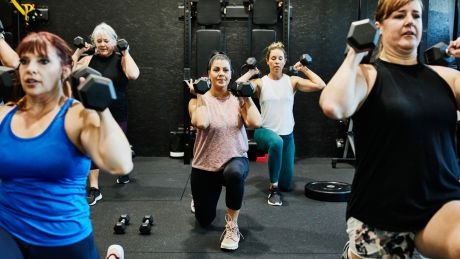
Booty, butt, backside: whatever you call it, everyone’s got one and everyone’s is big – at least in comparison with all the other muscles in your body. Yes, the gluteus maximus is the biggest muscle in your body, and it’s flanked and enhanced by the gluteus medius and gluteus minimus.
But despite their size, the glutes can often be criminally underused and inactive. Many of us spend long hours sitting at a desk and in a car, which means tight hip flexors, weak glute muscles and poor posture.
Strong glutes can not only contribute to better posture, they can also improve your workout efficiency. When you sprint, for example, a significant amount of power comes from your glute muscles. If these muscles are weak, you’re forced to rely more on the other lower-body muscles such as the hamstrings, quads and calves. It’s best to have all the lower-body muscles pulling their weight and working together.
For women who are pregnant, or planning to get pregnant, ensuring the glutes are active and strong can help support your pelvic floor, as well as helping lower the chance of back pain developing as your bump grows.
To keep your glutes active and strong, incorporate glute workouts like these into your exercise regime. We’ve put together three workouts – beginner, intermediate and advanced – each involving some or all of the six moves below. The beginner session doesn’t use any weights but you will need a stable platform like a weights bench. The more advanced workouts require dumbbells, a weights bench and a barbell with bumper weight plates.
Be sure to warm up and wake up your glutes before you start. This can be done with a mixture of bodyweight squats and lunges.
The Exercises
Dumbbell squat
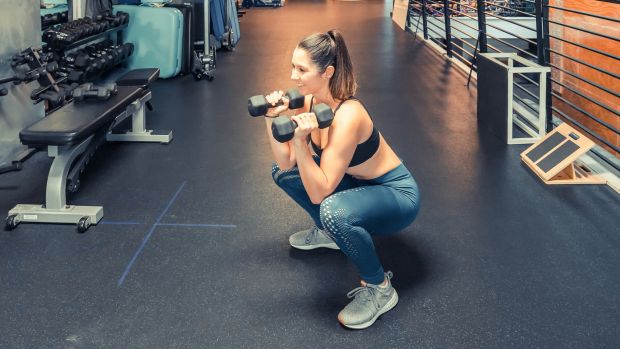
Stand with your feet just wider apart than hip-width apart and toes pointing out slightly. Hold dumbbells by your shoulders with your elbows pointing forwards. Throughout the movement, keep your core tight, back straight and heels on the floor. Lower by pushing your hips backwards and bending your knees until your thighs are parallel to the floor. To rise, push down through your heels.
Get the Coach Newsletter
Sign up for workout ideas, training advice, reviews of the latest gear and more.
Heel-raised closed-leg squat
Bring your feet closer together and place your heels on a raised surface, such as a thick bumper plate or a low step. Hold dumbbells by your shoulders. Lower into a squat, pause at the bottom, then push back up to standing.
Hip thrust
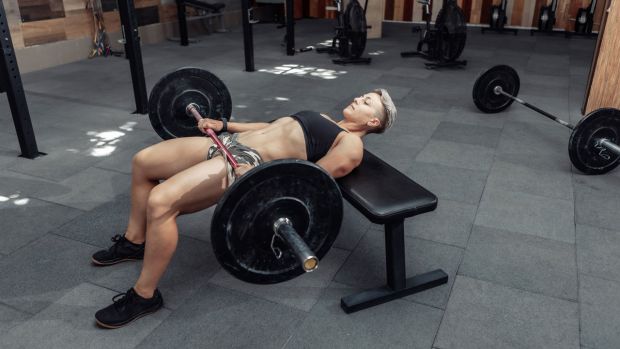
For this you’ll need a bench, and a barbell with bumper plates and a pad. Sit on the floor with your back upright against the bench, knees bent and feet flat on the floor. Place the bar just above your hips, lean back and, while keeping your shoulder blades on the bench throughout, drive your hips and the barbell up. Your knees should be at 90° at the top of the move. Squeeze your glutes, then slowly lower back to the start position.
Deadlift
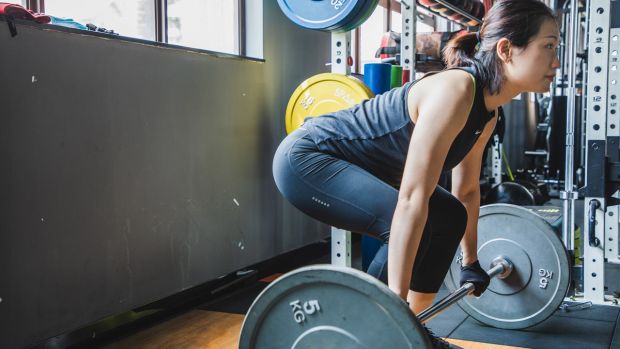
Set up a barbell with bumper plates so the bar sits higher off the ground. Stand with your feet hip-width apart and underneath the bar. Hinge forwards at your hips and bend your knees to lower and take hold of the bar with an overhand grip. Maintain a solid and straight neck and back, and keep the bar close to your legs. Push through your heels and pull the bar up to your knees. As you bring the bar past your knees, straighten your legs and pull the bar up until you are standing. To return to the start, glide the bar down your quads. When it reaches your knees, bend them to lower the bar to the floor. Remember, it’s essential to keep your back and neck in a straight line throughout.
Reverse lunge
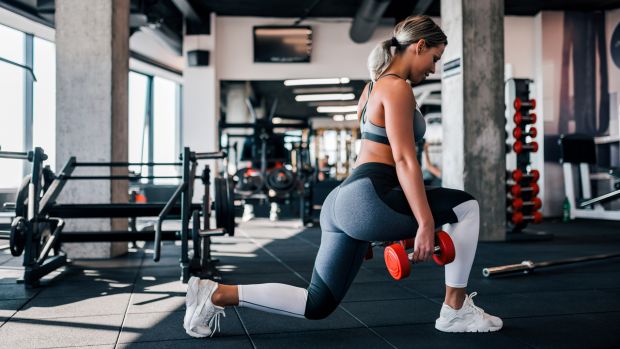
Unilateral work is a great way to identify and address any imbalances in your lower body. Holding dumbbells by your shoulders, keep your back straight and your gaze forwards as you step one leg back, bending your knees until your back knee is just above the ground. Try not to let your front knee go past your front toes. To return to the start, push through your front heel to rise back to standing, then repeat on the other side. If you can’t feel your glutes working while lunging, step slightly further out to the side as you move your leg back.
Bulgarian split squat
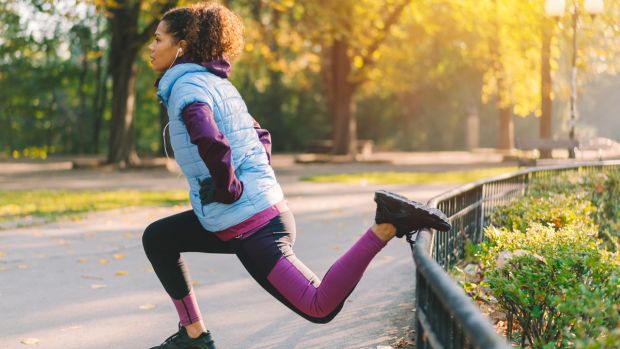
Place the top of your right foot on a bench behind you, with your right knee bent and right lower leg parallel to the floor. Lower by bending your left knee, making sure your knee doesn’t go beyond your toes – if it does, set up again with your left foot further forwards. Stop when your right knee is just above the ground. Pause, then push through your left heel to rise back to the start.
See related
- Feel The Burn With This Booty Workout From Fitness App SHREDDY
- The Best Glute Exercises For Women
- The Ultimate Resistance Band Glute Workout
- Krissy Cela’s Bum Workout Will Have Feeling Your Best
The Workouts
Beginner Glute Workout For Women
This workout solely uses bodyweight movements, but don’t let the lack of weights fool you into thinking it’s going to be easy! Starting with just your bodyweight ensures you get to grips with the form of each exercise, as well as ensuring you build up a good foundation of strength.
- Squat (Reps 10 Rest 45sec)
- Heel-raised closed-leg squat (Reps 10 Rest 45sec)
- Hip thrust (Reps 10 Rest 45sec)
- Reverse lunge (Reps 10 each side Rest 45sec)
- Bulgarian split squat (Reps 10 each side Rest 45sec)
Once you’ve run through all five moves, rest, then run through the exercises a second time.
Intermediate Glute Workout For Women
To step up the difficulty, incorporate light to medium weights, as well increasing the reps and shortening the periods of rest.
Repeat the following five times in total.
- Squat (Reps 15 Rest 30sec)
- Heel-raised closed-leg squat (Reps 15 Rest 30sec)
- Hip thrust (Reps 15 Rest 30sec)
- Reverse lunge (Reps 15 each side Rest 30sec)
- Bulgarian split squat (Reps 15 each side Rest 30sec)
- Deadlift (Reps 15 Rest 90sec)
Advanced Glute Workout For Women
To progress even further, increase the weight to a point where the last two reps of each set are difficult – you should be working really hard to complete the last rep. Because the weight has been increased, the reps come down.
Repeat the following three times in total.
- Squat (Sets 2 Reps 8 Rest 60sec)
- Heel-raised closed-leg squat (Sets 2 Reps 10 Rest 60sec)
- Hip thrust (Sets 2 Reps 5, pausing for 5sec at the top of each rep Rest 60sec)
- Deadlift (Sets 2 Reps 8 Rest 60sec)
- Reverse lunge (Sets 2 Reps 8 each side Rest 60sec)
- Bulgarian split squat (Sets 2 Reps 8 each side Rest 60sec)
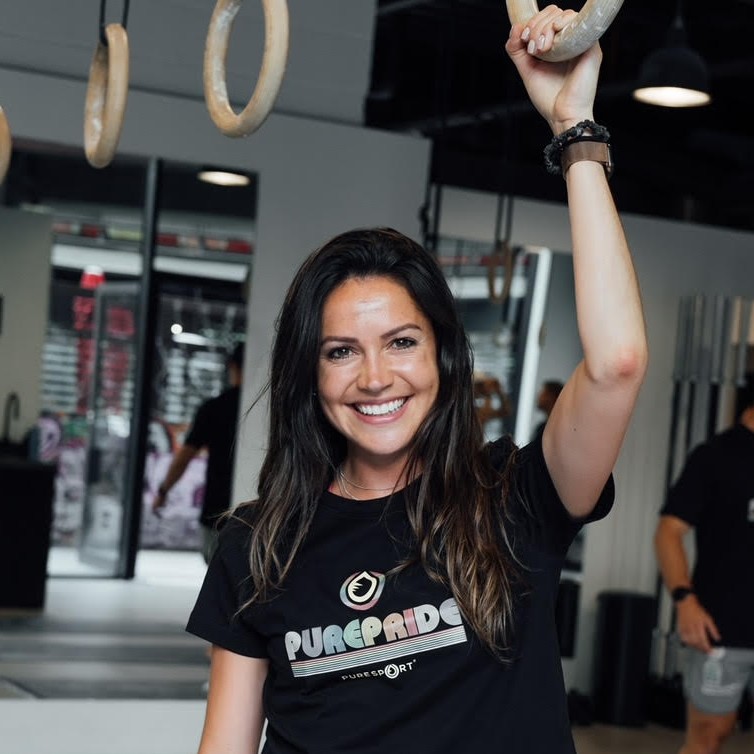
Lucy is an experienced health and fitness journalist, and was formerly health editor for TI Media’s portfolio of women’s titles. Lucy qualified as a level 3 personal trainer with Train Fitness in 2016, and also holds qualifications in pre- and post-natal fitness, as well as in nutrition for exercise.









